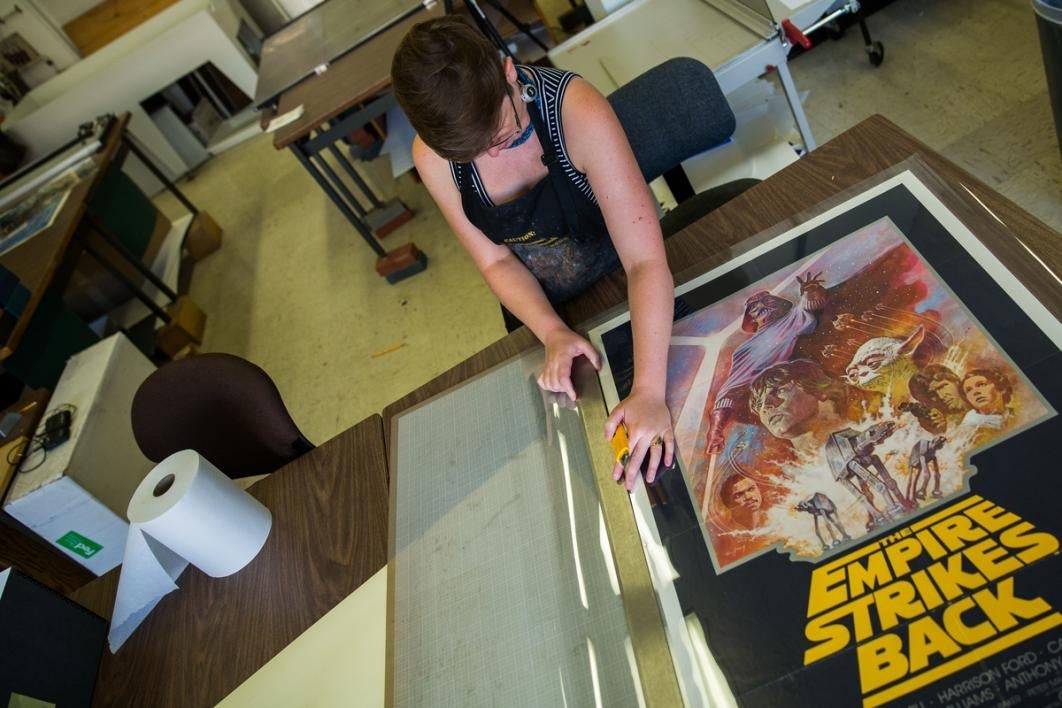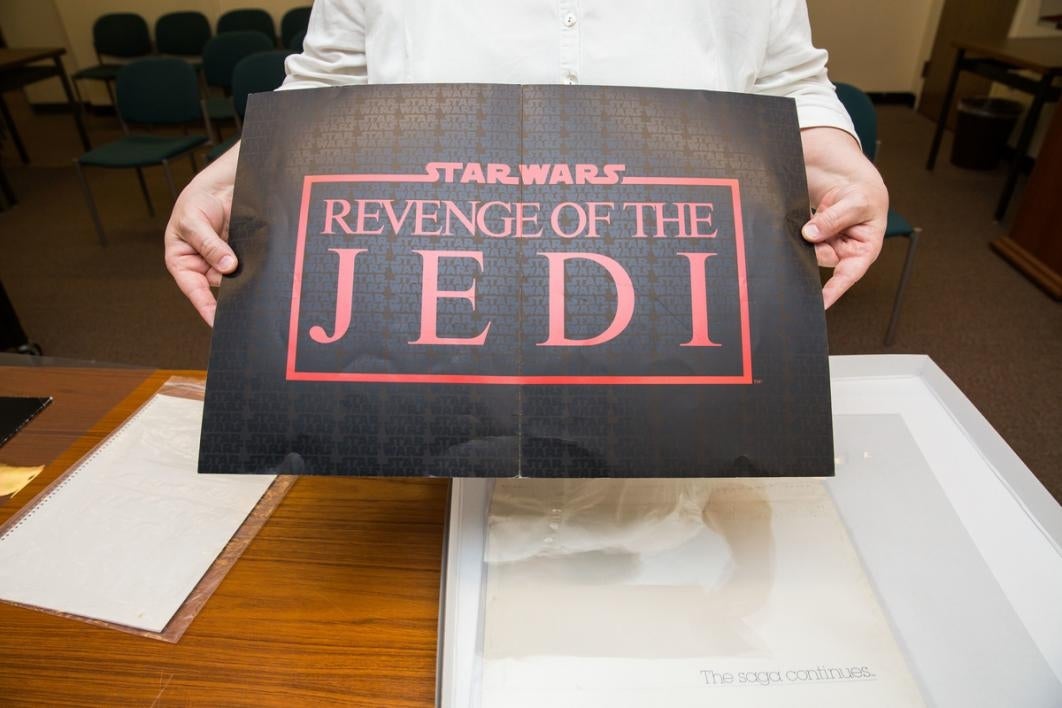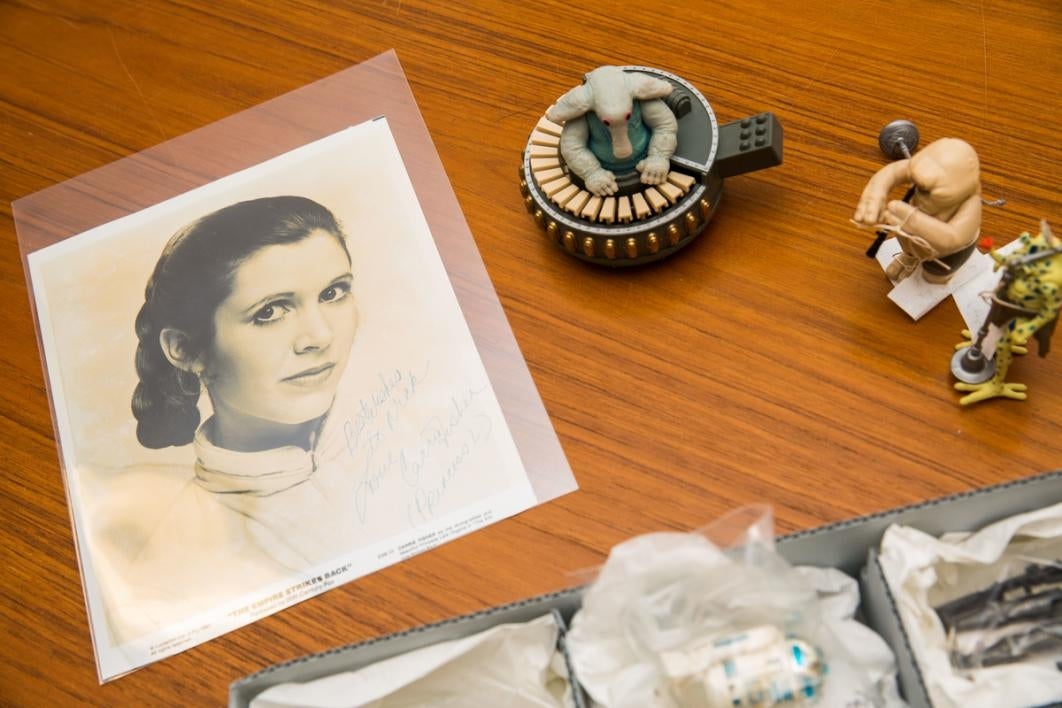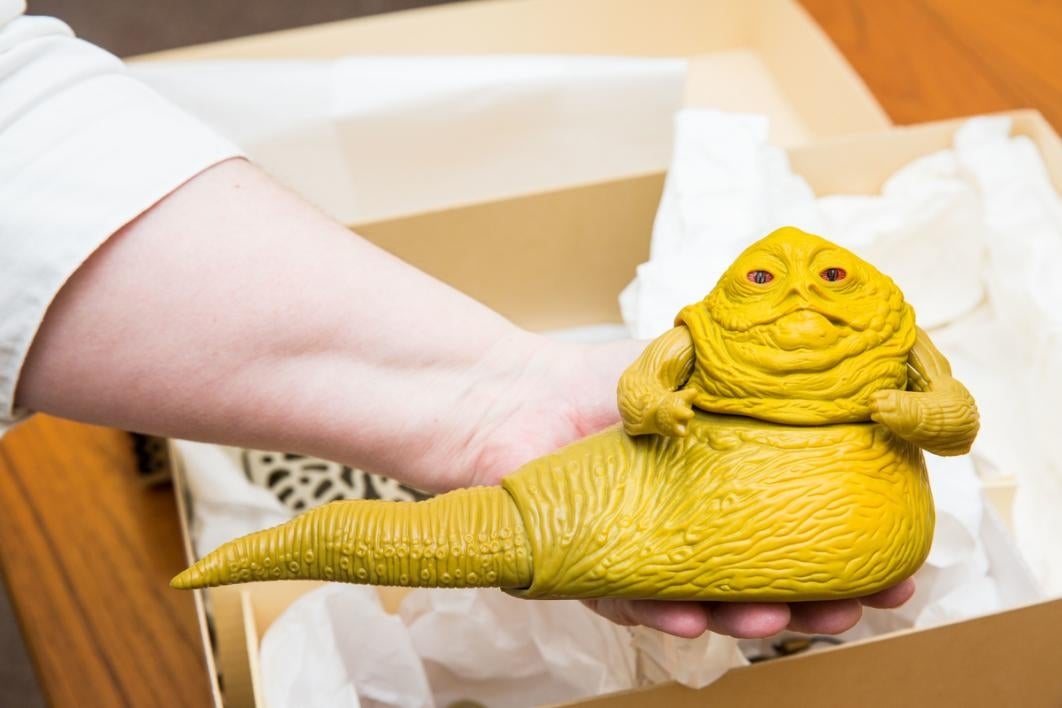Episode I: The origin of ASU’s 'Star Wars' universe
Nick Salerno tells people that he grew up in the dark.
As a child, Salerno would accompany his mother to a double feature at Phoenix’s Cine Capri on the two days she had off from working at the family grocery.
She was born in Sicily and was learning English at the movies.
He was developing a love for film.
“So I tell people I grew up in the dark,” said Salerno, a graduate of Arizona State University, professor emeritus and former chair of ASU’s English department. “And I’ve been seeing more than four movies a week ever since.”
In 1980, Salerno was teaching Victorian literature — his first love — and writing movie reviews for the Scottsdale Progress newspaper when he was invited to Los Angeles to attend a press junket for a new movie sequel called “The Empire Strikes Back.”
The trip was all expenses paid, so he went. He was sent a packet of promotional materials before he left, and soon found himself opposite young actors Mark Hamill (who played Luke Skywalker) and Harrison Ford (Han Solo). Also there were Carrie "Princess Leia" Fisher; Anthony Daniels, who played C-3PO; Darth Vader’s original actor David Prowse; director Irvin Kershner; and producer Gary Kurtz.
“Here I am interviewing all these people, and I wasn’t a fan of science fiction. This was a total immersion, all of a sudden,” Salerno said. “I fell in love with the film. I fell in love with R2-D2 and C-3PO.”
He kept the materials he received on his trip. Captivated, Salerno began filling his home and office with toys, posters, books and other branded materials of the “Star Wars” films.
Salerno related the story of Luke Skywalker, a hero in search of meaning and justice in the world, to classic Greek and Roman mythology — a keen observation, since franchise creator George Lucas modeled Skywalker’s character path after the Hero’s Journey.
“I thought film was a legitimate academic study,” he said. Salerno hosted movie watches on campus and eventually helped bring the university its first film studies course. “It took 10 years until I got the English department to agree to add a film course to the curriculum. And it just grew and grew.”
After Salerno retired from teaching in 1991, he donated his “Star Wars” collection to ASU. His action figures, spaceships, press passes, interview schedules, movie notes and media kits are now part of the Hayden Library’s special collections, where they are studied by film students and marketing enthusiasts alike.

Conservator Suzanne Morgan demonstrates how one would use a toy Millennium Falcon at the preservation department at Hayden Library on Tempe campus.
Photos by Deanna Dent/ASU Now
Episode II: Caring for what can’t be cloned
One of Katherine Krzys' first duties as archivist for Hayden Library was to take a cart and visit Salerno's office.
His shelves displayed "Star Wars" toys and memorabilia depicting scenes from the movies, complete with souvenirs hanging from the ceiling.
She carefully wrapped the items in tissue and packed them into boxes for their journey to Hayden Library. Since 1999, the collection remained in those boxes unless brought out for film, history of the book or popular culture classes.
“I couldn’t be happier that the collection is finally processed, and patrons can come to view it and it all happened while Nick is still with us," Krzys said. "That’s the best part.”
For several months, Susan Barrett, a knowledge manager for UTO Academic Technologies who has a background in library and information science, has volunteered part-time in Hayden Library’s special collections to meticulously process Salerno’s collection of “Star Wars”-related ephemera and memorabilia, as well as additional items that were donated once like-minded collectors became aware of ASU’s growing archive.
She catalogued each item alongside notes about its history and use and, in some cases, sent items to the library’s preservation department for conservation.
“The materials take on a whole new life. They are no longer just a child’s toy. They are now an archival resource for researchers and scholars for all over the world to come and learn about all the different things that a film’s merchandising teaches you,” Barrett said.
She pointed out a few examples of the collection’s rare materials: a publicity folder sealed with a metal medallion of Darth Vader that was distributed to only about 50 people; a fan club poster revealing the name of the series’ next film that reads “Revenge of the Jedi” and was sent before Lucas changed the title to “Return of the Jedi” (citing that Jedi would never have revenge in their hearts); figurines of Darth Vader and Luke Skywalker released before the first movie in which the color of each’s telescoping light saber doesn’t match what is in the film.
“It’s a unique and useful collection that certainly all of our film students should be aware of, if not the extended community as well,” said assistant professor Jason Scott, who teaches in the Herberger Institute for Design and the Arts’ School of Theatre and Film. His father was a publicist for 20th Century Fox, Universal Pictures and Walt Disney Pictures and wrote some of the press materials that are part of the special collections.
According to Suzanne Morgan, the library’s lead preservation specialist, the collection is a great example of the diversity of an archival collection.
“In the library we have everything from plastic toys to glass-plate negatives to books and documents to videos and films and audio reels,” she said. “It runs the whole gamut.”
Morgan is helping protect the collection for future scholars by building protective cases for some of the materials and cleaning and repairing them when needed.
Recently, she created a plastic-sleeve encapsulation for a large color poster that originally came packaged with one of the more than 100 unique action figures produced around the time of “Return of the Jedi.”
“ ‘Star Wars’ is forever,” Morgan read from the poster. “Which is really kind of true, we’re finding out.”
Episode III: Return (on investment) of the Jedi
The enduring collectables in the “Star Wars” marketing and publicity galaxy helped contribute to it being named the Guinness World Records’ most successful film merchandising franchise.
“Lucas is a kind of visionary, not just in terms of storytelling, but in terms of the business side,” said lecturer Michael Green, who teaches film and media studies in ASU’s College of Liberal Arts and Sciences’ Department of English. “He ended up making a huge amount of his money on the back of the marketing, branding and selling of all these components related to the film that weren’t the film itself. By the time of ‘Return of the Jedi,’ you had, say, 100 characters that could be action figures and 50 spaceships that could be sold as toys.”
For a point of reference on the toy revenue, Kenner grossed more than $100 million on action-figure sales in 1978. In 2011, “Star Wars” merchandising grossed more than $3 billion.
“The novelization of the movie represented such a fundamentally different way of understanding a movie audience as people who consumed beyond just the movie,” Scott said. In addition to his role at ASU, he is a freelance publicity and marketing consultant for entertainment firms in Los Angeles and New York.
Scott explained that effective film publicity makes a promise to the audience — such as whether they’ll get a lot of laughs or learn an important lesson. If the movie delivers on that promise, audiences respond positively because their expectations were met. That lends of a sense of ownership, which helps sell tickets, but also the souvenirs that go along with them.
“ ‘Star Wars’ has become an interesting, long-term case study in how marketing can initially help to brand a film, but then become a burden when people feel like they have so much ownership of it [but no control over the characters],” he said, pointing to pushback against the prequel films when fans felt they failed to live up to their trailers’ promises.
Notwithstanding, the franchise and its films have maintained a steady base of devotees, even when more than a decade past without a new film.
Although for most of the 1990s there weren't movies being made, "there were a lot of novels, role-playing games and comic books,” said Green, referring to what is known as the Star Wars “expanded universe.” “The story was still being disseminated in other media texts.”
Both professors explained that changes to film distribution helped “Star Wars” become — and remain — a mega-hit.
When it was first released in 1977, the VCR was gaining traction in the mass market. Soon, moviegoers who once had to rely on the experience of visiting a theater could instead watch films in their living rooms — prolonging the life of the story.
Now, with streaming video services, that story is likely to be extended in even more ways.
“With the way exhibition has changed — movies are now online, movies are being downloaded, movies are on your phone, your iPad, your computer, the airplane — the ability to market has become so pervasive because everywhere we have a screen,” said Green. “But we go to the movies for spectacle, which is why you get these big movies that don’t have the same effect on a small screen.”
Which means fans will still flock to the cineplex as the next “Star Wars” chapter hits theaters on Dec. 18. “The Force Awakens,” directed by self-admitted “Star Wars” fanboy J.J. Abrams, will continue the story that left off after “Return of the Jedi” and includes several of the original actors Salerno met during that 1980 press junket.
The new film has also inspired an entirely new batch of memorabilia and merchandising — from action figures to remote-controlled robots.
"From a historical perspective, [attempts to merchandise or market 'Star Wars'] show us how filmmakers and studios communicate social and cultural values to their audience," Scott said. "It's great to have these artifacts in our library collection at ASU — they not only bring us back in time and memory, but give us insight into how we thought about films and film audiences 'back then' versus how we understand them in the present day."
ASU Libraries invites classroom visits and scholarly research. The Nicholas A. Salerno 'Star Wars' Collection in ASU Libraries’ special collections can be viewed in the Luhrs Reading Room during the school year from 9 a.m.-6 p.m. weekdays and by appointment on Saturdays. The reading room is located on the fourth floor of the Hayden Library, and a staff member is always available to help locate materials. To learn more, contact 480-965-4932.
More Arts, humanities and education

Honoring innovative practices, impact in the field of American Indian studies
American Indian Studies at Arizona State University will host a panel event to celebrate the release of “From the Skin,” a collection over three years in the making centering stories, theories and…

ASU alum's humanities background led to fulfilling job with the governor's office
As a student, Arizona State University alumna Sambo Dul was a triple major in Spanish, political science and economics. After graduating, she leveraged the skills she cultivated in college —…

ASU English professor directs new Native play 'Antíkoni'
Over the last three years, Madeline Sayet toured the United States to tell her story in the autobiographical solo-performance play “Where We Belong.” Now, the clinical associate professor in…






